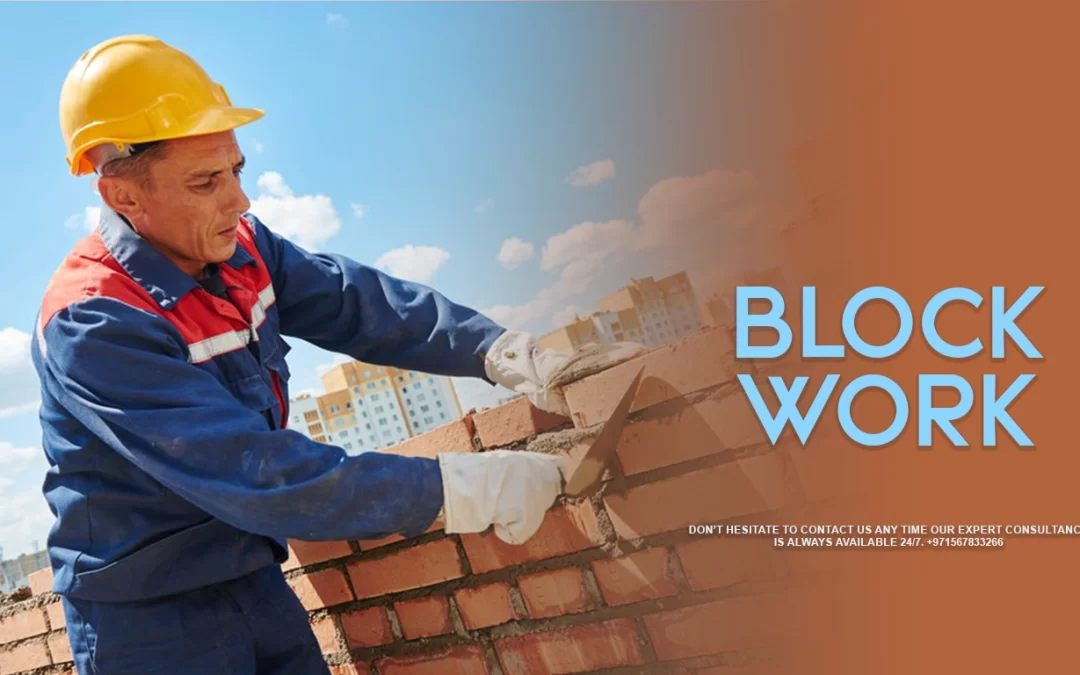block work is one of the most important works for any construction. Don’t hesitate to contact us any time
our expert consultancy is always available 24/7
Concrete blocks are very typical components of construction and are used all over the world.
Today’s construction industry uses a wide variety of sizes and types.
Let’s look at some examples of units used in construction work.
Dubai The face side is usually 450 x 225, and the thickness varies from 60mm to 150mm
and from 6.3 to 15kg. They are produced in solid, hollow, and multi-piece form.
Multiple cutters allow for no-waste prop cuts.
Precast block work walls can be divided into two main categories, i.e., load-bearing as well as non-bearing.
Block Work Different types of blocks
Bearing block work are pre-cast into molds and compressed with vibration aids,
molding machines that require the use of compressed air, or a mixture of both.
These block work are usually made of cement and concrete aggregate.
The cement is usually Portland cement and a number of aggregates are used.
It is also possible to pre-cast non-bearing block work into molds,
but others are made in slab form and cut to size when assembled.
These block work are usually made from a mixture of lightweight materials and cement,
such as coke waste, Breeze or Clinker waste, cinder, cement, fired clay, etc.
Block Work concrete blocks
Concrete blocks are flexible, durable, hard, fire-resistant,
and have excellent sound insulation.
An ideal background for even finishes and fixings in dry
and wet priming. The inherent thermal mass acts as a heat store.
These construction methods are tested and popular, without risk.
Easily available, fast, and cost-effective.
Work block method statement
In this construction activity, materials include:
Solid and hollow concrete building blocks
thermal masses
sand
Builds
Moisture-proof cycle
Steel construction accessories, headbands, side ties, etc.
cement-based non-shrinkage plaster etc
Tools required for block work
nail gun
Table mill for cutting blocks
scaffolding platforms
periodic line
Trowels and hand tools
mixer machine
Mason Square
water level
Wheelbarrow
Masonry saw
electric drills
3m long aluminum straight edge
spirit level
measuring tape
Vertical measurement
calibration survey tools.
Safety requirements for block work
A scaffold is constructed covering the work area up to the building level before the block wall is erected.
The scaffold is constructed to hold the materials that will be used in the construction of the block wall.
Scaffolding was erected to allow free access to each builder without cutting.
All workers working at heights must wear rope seat belts.
There will be blockers on the field where blocking takes place.
Blockwork installation
Ensuring approval of building materials, sample statement,
method and construction work accessories.
Construction work delivered on-site should be carefully unpacked
and stored to avoid chipping or breakage, and provide a random test sample.
On wooden pallets of sufficient size, the construction work units are placed in a dry position.
Ensure the correct size and location of all struts, bolts, screws, lintels, bangs,
and other embedded products are in place. Before work begins on blocks,
establish the location and location of all embedded MEP openings and elements.
A mock-up wall pattern shall be built in full size and the customer’s approval is given.
After block approval, mock-up work is performed.
Work in concrete blocks must fit the standard approved wall.
Teamwork procedures block work
1- The surveyor shall determine the work plan using the existing planning drawings.
2- In dry and hot climates, masonry units must be moistened before laying to prevent rapid drying and shrinkage of the cement mortar.
3- 200 thick thermal blocks must be used for all external walls, or according to the approved executive plans.
4- DPC approved material must be pre-placed at the base of the wall along the block wall alignment.
The width of the DPC material shall be the same as the specified thickness of the blocks specified in the approved shop drawing.
5- The first layer of blocks shall be solid blocks and fully set with proper alignment.
6- The blocks must be placed correctly on a complete mortar layer.
The thickness of the general-purpose mortar joints will be from 8mm to 12mm.
7- It is preferable to mix the mortar made on site by machine.
Mixing mortar for brick walls block work
1- The mortar mixture ratio is 1:6 OPC/Sand for CMU blocks and 1:4 OPC/Sand for refractory blocks or as specified.
2- Add and mix well and uniformly in enough water to make a mortar ball firmly in the man’s hand and to drip lightly through the fingers when the hand is closed.
3- Do not mix more mortar than can be used within 1.5 hours. Unused slurry should be discarded within an hour and a half. Do not re-smooth the mortar.
4- Place the building on the marked lines and levels. Building units shall be placed with two-story rails
so that the zigzag lines are at the angles of the steel shelves, sills, window heads, and full-turn doors.
5- The building units will be combined with each other overlapping so that the vertical connections range from one track to another.
6- The horizontal anchors of the building walls shall be respected according to the specifications.
7- All horizontal joints must be leveled and the vertical joint aligned during construction.
8- Masonry cutting should be done by automatic stone saw.
Cut the MEP into the Wall Block
Maintain openings to drawing and cut units to accommodate framing, channels, fixtures, gaps and other MEP within wall block work.
Doors in block wall
As work progresses, install metal door frames, fabricated metal frames, anchor bolts for window frames,
baseboards, ducts, pipes, and other embedded items to the work.
Each frame must be both jammed and plumb and properly positioned.
Block works shall be constructed according to the dimensions, thickness, and height mentioned in the drawing.
Work block treat
3 days block wet curing work, 7 days sills and sills as per project specification.
Building cleaning
While work is in progress, carefully remove slicks of mortar from masonry and adjacent surfaces.
After completing each section of wall brickwork,
clean and thoroughly prime the surfaces where required.
General requirements
The walls should also be kept standard. Sections of the wall with a height of more than 1.2 meters must not be installed on a given day.
Take walls uniformly, no part above any unbuilt adjoining course to 1000mm,
and no wall area higher than 650mm at any distance not quite fixed.
The nooks and crannies stay real, square,
and plumbed. Broken walls must be put up with bullets.
The walls shall be built as true levels, and in either direction,
shall be within 3mm and plumb within 4mm if measured by a straight edge of 3000mm laid anywhere on the wall.
across all walls around the building, all horizontal.
The joint is of equal height, and level and according to the lines of the designs shown.
Unsatisfactory work is removed and replaced.
The walls of the concrete cross wall in the masonry bond must be joined together.
Extend construction fabric to within 20 mm of the frame base unless otherwise indicated.
Fill the 20 mm separation space under 25 percent pressure,
leaving space on each side of the finishing wall to dampen the joints.
Using concrete walls to install reinforced concrete sills on openings.
It shall bear at least 200 mm of the lintel on the masonry support.
Place sturdy concrete steel locking blocks over the entire concrete block uprights.
The load-bearing blocks are made of the same material as the outer wall.
Don’t hesitate to contact us any time our expert consultancy is always available 24/7.
+971567833266
Explore more about our service
House Painting Services Dubai | 0567833266
Handyman Services Dubai | Handyman | 0567833266
إيجاري | EJARI | OFFICE AGRIMANT | 0567833266

